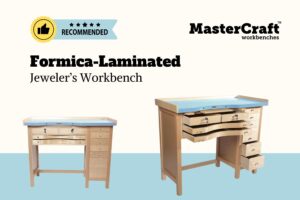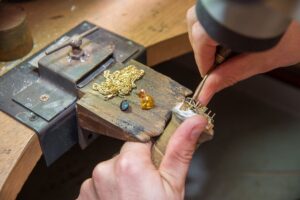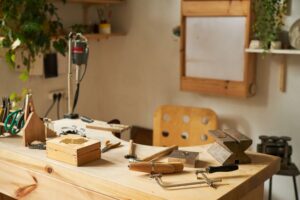Jewelry-making is an ancient craft that has spanned thousands of years, and the jeweler’s workbench has always been at the heart of this art. While today’s workbenches are sophisticated tools designed with ergonomics and efficiency in mind, they have evolved from much simpler beginnings. Let’s explore the journey of the jeweler’s workbench from its origins to the advanced designs we see today, including how modern innovations, such as those from Mastercraft Workbenches, are continuing to push the boundaries of functionality and style.
Early Origins of the Jeweler’s Workbench
The earliest iterations of the jeweler’s workbench can be traced back to ancient civilizations. Ancient Egyptian, Roman, and Greek artisans crafted jewelry using rudimentary benches—often little more than simple wooden tables. These benches allowed jewelers to work with precious metals, gemstones, and basic tools like hammers, files, and chisels. Their main purpose was to provide a flat, stable surface on which these early artisans could work, though they lacked the storage and ergonomic design found in modern benches.
As jewelry-making became more refined, the workbenches slowly evolved to accommodate more complex tools and techniques. Jewelers of the Middle Ages and the Renaissance era were known to use specialized benches with shallow trays to catch gold and silver filings—a feature that continues to be used in modern workbenches. These early benches reflected the growing complexity of jewelry designs, as well as the increasing need to manage fine materials more efficiently.
The Industrial Revolution: Shaping Modern Jeweler’s Workbenches
With the advent of the Industrial Revolution in the 18th and 19th centuries, the jeweler’s workbench underwent significant changes. The increase in mass production meant that tools became more standardized, and jewelers’ benches were adapted to accommodate these new instruments. The introduction of mechanical devices like lathes and polishing wheels required sturdier benches that could withstand vibration and movement. As jewelry manufacturing scaled up, workbenches began to incorporate multiple drawers for storing various tools and materials.
This period also saw the introduction of ergonomic improvements. As jewelry-making became more specialized, the jeweler’s posture became a critical factor in productivity and health. Benches were modified with adjustable seating heights, armrests, and tool trays that kept everything within easy reach. These early advancements laid the groundwork for the workbench designs we see today.
The Modern Jeweler’s Workbench
In the 20th and 21st centuries, the jeweler’s workbench has continued to evolve alongside innovations in craftsmanship and technology. Today’s workbenches, such as those crafted by Mastercraft Workbenches, reflect a perfect balance of tradition and modern innovation. Here’s how contemporary workbenches have been shaped by the needs of modern jewelers:
Ergonomics and Comfort: Today’s jewelers often spend long hours at their benches, working on intricate pieces. Modern designs incorporate ergonomic features such as curved cut-outs on the tabletop, adjustable pull-out armrests, and customizable heights to ensure comfort during prolonged sessions. For example, the MO-50 workbench features these ergonomic improvements, allowing for better posture and reduced fatigue.
Durability and Stability: Jewelers today require robust surfaces to support heavy tools and withstand the heat from soldering and other processes. Benches like the PN-100 by Mastercraft feature a 1½-inch thick Formica laminated natural birch plywood tabletop, which offers exceptional durability and heat resistance. This ensures that the workbench remains sturdy and reliable for even the most demanding tasks.
Tool Organization and Efficiency: Modern workbenches are designed with organization in mind. Multiple drawers, tool trays, and slots for essential items like bench pins allow jewelers to keep their workspace neat and functional. The Olympic Grande model, for instance, features ample storage options, including lockable drawers and pull-out trays for easy access to tools and materials, which improves the jeweler’s workflow.
Aesthetic Appeal: While functionality is paramount, modern jewelers also seek aesthetically pleasing workbenches that enhance their studio environment. Stylish details like polished knobs, sleek designs, and high-quality materials like natural birch provide both function and form. Mastercraft’s workbenches blend style with practicality, offering jewelers a workbench that complements the beauty of the craft itself.
The Future of Jeweler’s Workbenches
As technology advances, the future of jeweler’s workbenches will likely see even more innovations. From smart workbenches that incorporate digital tool integration to modular designs that adapt to a jeweler’s changing needs, the possibilities are endless. However, the core of the workbench—its ability to support the creative process—will remain unchanged.
In conclusion, the jeweler’s workbench has come a long way from its humble beginnings. Today’s benches are the result of centuries of refinement, innovation, and adaptation to the evolving needs of jewelers. With brands like Mastercraft Workbenches leading the way, modern workbenches not only serve as functional tools but also as essential elements that help jewelers bring their creative visions to life.
For more information on modern jeweler’s workbenches and to explore a range of models tailored to both beginners and professionals, visit Mastercraft Workbenches.
Need some inspiration? Check out other blog posts!
Browse Jeweler's Workbenches
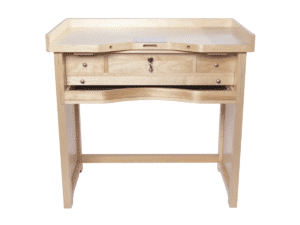
Featured
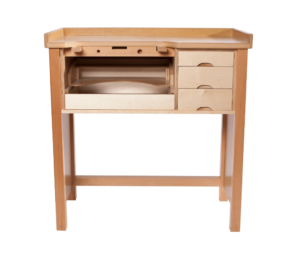
Small Workbenches
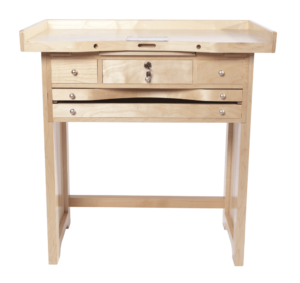
Small Workbenches

Small Workbenches


